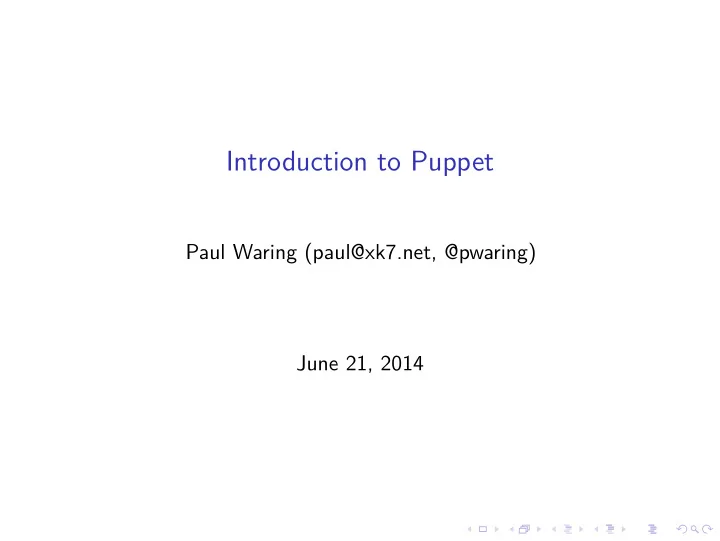

Introduction to Puppet Paul Waring (paul@xk7.net, @pwaring) June 21, 2014
Configuration management and provisioning ◮ Define how a machine should be setup ◮ Configuration, software installed, users etc. ◮ Manage large numbers of machines - especially identical ones ◮ Quick redeployment of server ◮ Development matches production ◮ Ensure a consistent state, even if local edits made
What is Puppet? ◮ Configuration management and provisioning ◮ Apache 2.0 licence since v2.7 ◮ Declarative vs imperative ◮ Describe desired state of server, Puppet makes it so
Puppet Labs ◮ Commercial company behind the software ◮ Enterprise platform available ◮ Support, training, conferences etc.
Support ◮ Community: mailing lists, IRC etc. ◮ Commercial: Puppet Labs, contractors etc.
Alternatives ◮ Ansible ◮ Chef ◮ cfengine
Why Puppet? ◮ Large ecosystem and community ◮ Lots of documentation (wikis, books etc.)
Why not Puppet? ◮ Requires an agent on all machines ◮ Extra firewall rules ◮ Bootstrapping problem ◮ You hate Ruby
Manifests ◮ Describe how a system should be configured ◮ Plain text files, Ruby syntax ◮ Write manifests once, run anywhere (mostly)
Vagrant Provisioning ◮ Start up a VM and configure it automatically ◮ Will be used in all examples
Resources ◮ Basic building blocks of manifests ◮ Standard types: package , exec , service etc. ◮ Define your own resource types ◮ Third party resource types: mysql , apache etc. Generic example resource_type { "identifier": attribute1 = value, attribute2 = value, }
Package resource Controls packages installed on the system. Attributes ◮ name : Name (from package management system), defaults to identifier ◮ ensure : What state the package should be in Examples package { "nethack-common": ensure = present, } package { "php5": ensure = absent, }
Exec resource Execute specific commands which are not represented by resources (e.g. there is no ‘compressed’ resource type). Examples exec { "unpack_moodle_db": unless = "/usr/bin/test -f /home/vagrant/moodle.sql", command = "/bin/gunzip /home/vagrant/moodle.sql.gz", } exec { "unpack_moodle_code": cwd = "/home/vagrant/www/moodle2/htdocs", command = "/bin/tar --strip-components=1 \ -xzf /home/vagrant/moodle-2.2.11.tgz", }
Service resource Ensure services are running (or not). service { 'apache2': ensure = running, enable = true, }
MySQL resource Optional resource made available by Puppet Labs. puppet module install puppetlabs-mysql mysql_user { 'puppet@localhost': ensure = present, } mysql_database { 'puppet': ensure = present, } mysql_grant { 'puppet@localhost/puppet.*': ensure = present, options = ['GRANT'], privileges = ['ALL'], table = 'puppet.*', user = 'puppet@localhost', }
Resource ordering Occasionally resources need to be processed in a particular order which Puppet cannot determine. Examples file { "/home/vagrant/moodle-latest-26.tgz": ensure = present, source = "/vagrant_data/moodle-latest-26.tgz", before = Exec["unpack_moodle_code"], } exec { "unpack_moodle_code": cwd = "/home/vagrant/www/moodle2/htdocs", command = "/bin/tar --strip-components=1 \ -xzf /home/vagrant/moodle-latest-26.tgz", }
Questions ◮ Slides and scripts on GitHub under BSD Licence ◮ https://github.com/pwaring/puppet-talk
Recommend
More recommend